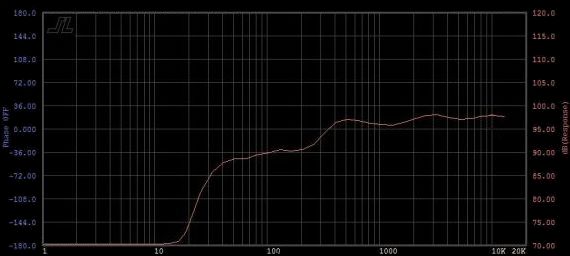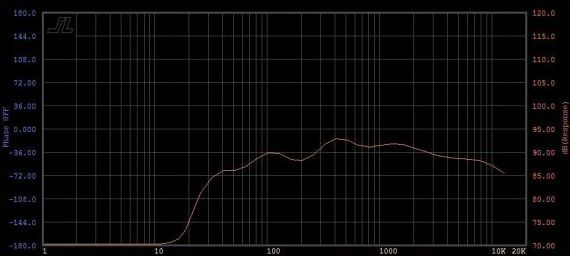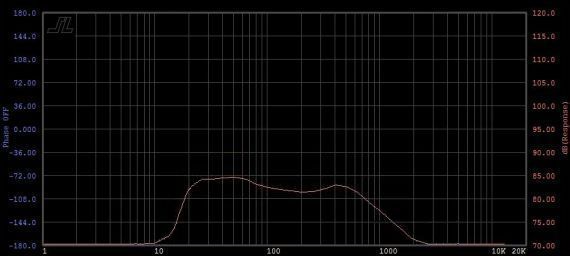|
Home » Sponsored » Pi Speakers » New Year, New Tweeter, Merry Christmas
| New Year, New Tweeter, Merry Christmas [message #65420] |
Sat, 25 December 2010 12:22  |
 Bill Epstein
Bill Epstein
Messages: 1088
Registered: May 2009
Location: Smoky Mts. USA
|
Illuminati (2nd Degree) |
|
|
S-B Acoustics is built from the staff that was ousted after Ken Kantnor (NHT) bought Peerless and made Tymphany.
The Zaphaudio guy has been using S-Bs SB29RDC ($55 each) in his latest designs. 600Fs, 93.5dB sensitive, super-low distortion and a massive faceplate; it's KILLER! Destroys the Vifa DX25T from the 2Pi.
With just a few hours, it's a tad darker and/or slightly recessed compared to the the Vifa but oh so much more revealing of tone and texture, especially tone; you can almost feel the harmonics from Dobro, male and female voice.
The 2-way I've had as 'garage speakers' with the 12" Altec-University woofers are now running with the 4Pis. What the A-Hs lack in comparison to the 2226s they almost replace with deeper, more powerful bass. And in a sealed cabinet so that bass is also tuneful. I've got a 20uF cap on the S-B for a low 2000Hz first-order cross which also helps the woofer make music.
The 4Pi is still the better speaker but this high-quality dynamic tweeter makes an enjoyable alternative, a different window on the music.
|
|
|
|
|
|
|
|
| Constant directivity verses on-axis EQ for non-uniform directivity (aka baffle step filters) [message #65424 is a reply to message #65423] |
Sun, 26 December 2010 22:09   |
 |
 Wayne Parham
Wayne Parham
Messages: 18985
Registered: January 2001
|
Illuminati (33rd Degree) |
|
|
I'm not a proponent of baffle step compensation, at least not for physically large speakers like mine. This is especially true for speakers that have constant directivity because baffle step is caused by a directivity change. If a speaker has constant directivity, it can't possibly have the so called baffle step.
Of course, most speakers don't have constant directivity through the whole audio range. The only loudspeaker I know of that can truly maintain constant directivity all the way down to the Schroeder frequency is the π cornerhorn.
Still, physically large speakers have a baffle large enough that the baffle step frequency is in or near the modal range, and directivity loses its meaning there. So I'm not big on baffle step compensation for most speakers, at least not the kind I'm interested in.
It is important to realize that baffle step compensation is on-axis equalization for non-uniform directivity. It is probably worthwhile for mini-monitors, because those need some voicing anyway. That kind of speaker generally isn't very efficient though, and if it uses a baffle step filter in the crossover, even less so. Those kinds of speakers and that whole design philosophy just isn't my thing.
The idea behind baffle step compensation does have some merit, don't get me wrong. The power response of a speaker and the on-axis response are the same only if it has constant directivity. But if the directivity collapses in a frequency range, the on-axis SPL goes up in that range. Almost every baffled speaker has a directivity change from half-space to some wider angle (depending on the environment) below the frequency where the baffle becomes acoustically small. Where directivity widens, SPL drops and that's why baffle step filters boost the bass. If a speaker is used outdoors or in a very large space, this makes sense because the speaker radiates omnidirectionally at low frequencies but directivity narrows at the baffle step frequency.
The problem is speakers act differently indoors than in freespace. The room sets the directivity at low frequencies, not the speaker. So baffle step is non-sequiter, because it equalizes the on-axis response to conjugate a hypothetical directivity change from half-space to full-space but this isn't what really happens, at least not in a home hifi setup. What actually happens is the room sets the pattern (and therefore, response) up to the Schroeder frequency.
Only above the Schroeder frequency does the speaker set the pattern. If the baffle is large, the pattern is probably half-space or smaller already, and therefore there is no baffle step. If the speaker is small, then there may be a range of frequencies that is radiated into an angle larger than half-space before the baffle begins to set the pattern. But the room will likely still constrain the pattern smaller than freespace, especially if the speaker is near any boundaries.
My conclusion has always been that the problem of low-to-mid frequency radiation and how to equalize for any change of pattern is complex and doesn't lend itself to a cookie-cutter approach like baffle step compensation filters. It is probably worthwhile in speakers designed to be used outdoors or in very large spaces, but those are most likely high-power speakers that use subs to fill in the bottom end. For home hifi speakers, I see it most often used on "wee little" speakers, essentially for voicing. My approach has always been to get a handle on directivity, which is the root cause.
|
|
|
|
|
|
| Re: Constant directivity verses on-axis EQ for non-uniform directivity (aka baffle step filters) [message #65429 is a reply to message #65427] |
Mon, 27 December 2010 10:12   |
 |
 Wayne Parham
Wayne Parham
Messages: 18985
Registered: January 2001
|
Illuminati (33rd Degree) |
|
|
Glad it was helpful. I hope it made sense and wasn't too abstract.
I find myself getting a lot of the same questions and comments over the years, and I tend to link to past posts in reply. I had a list of about a dozen posts that sort of covered the main concepts, and I linked to them when I wanted to give a basic overview. So I decided that a whitepaper that hit all the high points made more sense.
I should also point out that my reply, while in Bill's thread, was really for others that may drop in and read about baffle step. Bill has been a regular here for about 10 years, and has built just about everything I've designed. We've done the same trade shows more than once - I've been to his woodworking seminars and he's been to my crossover seminars. So most of this stuff is not news to him.
Baffle step compensation is one of the recurring discussion topics I feel somewhat strongly about. As I've said, it makes sense to me in the little milk carton sized mini-monitors, voicing them to provide more body. But speakers larger than that probably shouldn't have baffle step correction because the transition frequency is close to the Schroeder frequency. Below that, directivity loses its meaning.
You don't want to equalize what is essentially a directivity issue in a region where directivity has no meaning. Baffle step compensation circuits are designed under an assumption that there is a transition from 4π to 2π radiation. But that isn't true at 200Hz. If the baffle step transition doesn't occur above about 300Hz, then it doesn't happen at all. Not indoors, not in a home hifi environment.
All of my speakers are large enough that the baffle constrains the radiation angle to halfspace above the Schroeder frequency of most living rooms. The larger three π and four π models radiate halfspace at 300Hz up, and even the smaller one π and two π speakers radiate halfspace from 400Hz up. If they were used outdoors and flown in freespace where there was no boundary reinforcement, you would definitely want to equalize to compensate for baffle step. But indoors, you definitely don't want boost at those frequencies because room modes set the pattern, not the baffle. If you want to add power in that region, multisubs are the best option, not equalization.
Some say a picture is worth a thousand words, so let's add pictures to illustrate:
The response curve shown below is of one of our larger DI-matched two-way speakers, measured in freespace. It is a good representation of all our DI-matched two-way models, and is what you would expect if they were used outdoors, flown high off the ground with no boundary reinforcement. If you compare this with our published halfspace measurements, the baffle directivity transition is easy to see:
 DI-matched two-way loudspeaker on-axis, measured in freespace
DI-matched two-way loudspeaker on-axis, measured in freespace
You'll notice that below 300Hz, SPL is reduced by 6dB having the characteristic "baffle step" shelf. Many designers would point to this and immediately suggest a baffle-step correction circuit. If used outdoors or in a really large room, I might be inclined to agree. But then again, if used outdoors or in a really large room, I'd probably opt for a larger baffle and subs to cover the range. The point is, what we see here is on-axis response shows less output below 300Hz because the baffle constrains the radiating angle above that point. That's the key - This is a directivity shift, not a reduction in acoustic power.
Look at the same speaker rotated 45°, again, measured in freespace:
 DI-matched two-way loudspeaker rotated 45°, measured in freespace
DI-matched two-way loudspeaker rotated 45°, measured in freespace
Notice that off-axis energy is reduced at higher frequencies, but not at the lowest frequencies, where radiation is omnidirectional. If we were to have installed a baffle compensation circuit, the bass would be louder than the midrange and treble.
As we rotate further, passing the baffle angle, out to the side and around to the back of the speaker, the treble is completely lost and all that is radiated is the bass and lower midrange. So at these angles, a baffle correction circuit makes the spectral balance even worse.
 DI-matched two-way loudspeaker rotated just past 90°, measured in freespace
DI-matched two-way loudspeaker rotated just past 90°, measured in freespace
Some say this doesn't matter because the listener isn't ever going to be in those positions but that discounts the very important aspect of the spectral balance of the reverberent field. Indoors sound is not just direct, but a combination of direct and reflected sounds, and this is even more the case at low frequencies where most of what you hear is combined direct and reflected energies.
This is one of the reasons why the constant directivity cornerhorn approach is so attractive. All energies are thrown forward - There is no omnidirectional radiation because the walls constrain the pattern and limit the beamwidth to 90°. There is no "baffle step" and sound is constant throughout the room. Of course, room modes still setup but these can be mitgated using a multisub setup. But above the modal region, the sound radiation is constant and the spectral balance is uniform throughout the room.
|
|
|
|
|
|
|
|
|
|
|
|
Goto Forum:
Current Time: Mon Dec 15 01:56:18 CST 2025
|







